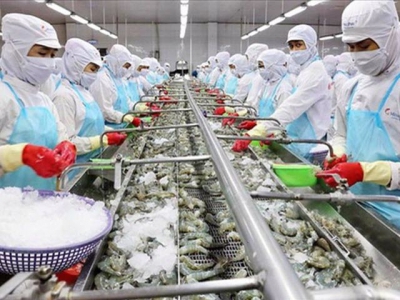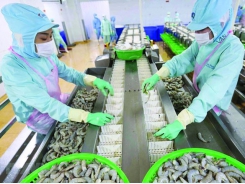Seafood processors in difficult spot

As social distancing continues, 120 of the 449 seafood processing plants in the Mekong Delta have ceased operations. The remainder are working at just 30-40 per cent of capacity. Production has increased as a result, with delays in orders triggering penalties.
Unpleasant stories that have been causing headaches for seafood businesses for many months have been brought and presented at the meeting: "Seafood production and consumption in the last months of 2021 and difficulties in the context of Covid-19 epidemic” organized by the Ministry of Agriculture and Rural Development, September 4, 2021 in an online form.
120 SEAFOOD PROCESSING FACTORY CLOSED
Mr. Tran Dinh Luan, Director of the General Department of Fisheries, said seafood exports in August 2021 decreased sharply in seafood products (tuna); Pangasius and shrimp decreased by 29.7% compared to the previous month. However, in the first eight months of 2021, seafood export turnover reached over $5.6 billion, up 7.1% over the same period.
Regarding the production situation of seafood enterprises, Mr. Luan added that in the Mekong Delta provinces, 120 out of 449 seafood processing factories stopped operating; The remaining factories have only about 30-40% capacity. Factory production costs increase, the risk of delay and penalty orders is very large.
Aquaculture is also very difficult, due to the epidemic, it is difficult to call traders, factories to buy seafood, lack of drivers, means of transportation to purchase raw shrimp... causing the price of raw shrimp to drop sharply .
The supply of input materials (seedlings, feed, drugs, chemicals, products to treat and improve the aquaculture environment) did not respond in time, resulting in increased costs due to transshipment and covid testing.
"The number of ships entering the port to load and unload seafood at 25 ports decreased by 59,670 vessels, equivalent to 334,000 tons. The loading and unloading, trading, especially the transportation of seafood with other provinces faced difficulties, leading to consumption. consumption of exploited aquatic products is slow and broken".
Ms. Vo Thi Thanh Van - Deputy Director of An Giang Department of Agriculture and Rural Development.
Ms. Vo Thi Thanh Van, Deputy Director of An Giang Department of Agriculture and Rural Development, said that it is expected that the locality will harvest about 157,000 tons of pangasius from now until the end of the year. Regarding fishing activities, as of September 1, 8 ports have been reopened, and 17 ports are currently temporarily closed.
Mr. Nguyen Van Buoi, Deputy Director of the Department of Agriculture and Rural Development of Ben Tre province, reflected that shrimp prices are now below cost because there is no local processing factory. Currently, shrimp farming households are all at a loss.
"In the past, traders who went to buy shrimp used to have to go a lot, each trader had someone to go to pull the net to catch shrimp and weigh shrimp. But now they refuse to go, the workers to harvest shrimp are very short, now they hire up to 6 million VND. VND/ton is also no one to go to pull shrimp. At present, the price of shrimp has dropped sharply while feed, biological products, medicine have increased... leading to an increase in input costs. Farmers are afraid not to stock the next crop," he said. Bui stated fact.
Therefore, to support seafood processing enterprises, Mr. Buoi suggested that there should be a policy to reduce interest rates on bank loans. Along with that, the Ministry of Agriculture and Rural Development should make a written request to the Prime Minister to direct the Ministry of Industry and Trade and the electricity sector to reduce electricity bills for hi-tech aquaculture farmers.
"Currently, Ben Tre has 1,950 hectares of high-tech shrimp farming, and the electricity bill is huge, so we hope the government will reduce the electricity bill for 6 months (until March 2022), with a reduction of 15-20%," suggested Mr. Buoi.
FOUR PRESSURES TO REMOVE
Mr. Nguyen Hoai Nam, Deputy General Secretary of the Association of Seafood Exporters and Producers (VASEP) said that at first, businesses thought that the distance would only be for about two weeks, so they should coordinate goods in stock for customers. But now the distance is prolonged, businesses do not have enough goods to deliver to customers.
"This is a very stressful week because businesses have to talk with partners to extend and delay orders. Localities often come up with policies very quickly, regulations are issued very urgently in social distancing, making it difficult for businesses to relax. businesses can't keep up," reflected Mr. Nam.
According to Mr. Nam, the seafood industry is currently facing four pressures. Firstly, in the southern provinces, 70% of factories had to stop production due to disease-related problems and in the remaining factories, the number of workers going to work was only about 20-40%.
This has resulted in a serious reduction in processing capacity, and businesses have not been able to pay orders and have not been able to purchase raw materials for fishermen and farmers.
Second, the continuous extension of the isolation period makes many customers impatient.
Third, raw materials, auxiliary materials and inputs of the seafood industry are scarce and difficult to access because each locality has different anti-epidemic policies, making transportation difficult.
"Production costs per unit increased very high, but at the end of the month of social insurance, unions still charge a percentage of wages, while businesses stop production for the whole month."
Mr. Nguyen Hoai Nam, Deputy Secretary General of VASEP.
Fourth, the pressure of funding. Businesses still have to pay for the number of employees on leave, and for those who work in "3 places", the cost increases 1.5 times compared to normal.
Therefore, VASEP proposed to the Ministry of Agriculture and Rural Development to influence the southern regions to give priority to vaccination with the first dose for people working in the fisheries industry. Although some have prioritized vaccination for seafood processing workers, but Ca Mau, Bac Lieu, Soc Trang ... but many other provinces have not vaccinated this industry.
At the same time, the Ministry of Agriculture and Rural Development works with localities when businesses submit production plans when the distance is eased, thus helping production plans to be approved faster.
In addition, VASEP also wants the Ministry to propose localities to reopen wholesale markets in big cities to promote consumption and create conditions for fishermen and farmers to have the motivation to return to production.
Deputy Minister of Agriculture and Rural Development Phung Duc Tien emphasized that fishery plays a very important role, accounting for about 35% of the total value of the agricultural industry and is an area with much room for growth. The remaining months of this year must achieve 2.9 million tons of seafood to ensure the target of 8.6 million tons of seafood for the whole year.
On the issue of vaccination for workers in the agricultural industry, Deputy Minister Tien affirmed that he had done very resolutely and sent documents to localities.
As for transport, the Deputy Minister said that as long as there is agreement between localities and a plan to manage drivers, the problem will be solved.
In addition, the issues of supporting capital, money and interest rates for businesses facing difficulties in the current period, the Ministry of Agriculture and Rural Development has also worked very urgently with relevant units.
"Enterprises and associations need to be reviewed, those businesses that are facing difficulties and problems, the association will submit a specific list for the Ministry to handle" Deputy Minister Tien requested.
Có thể bạn quan tâm
Phần mềm

Phối trộn thức ăn chăn nuôi

Pha dung dịch thủy canh

Định mức cho tôm ăn

Phối trộn phân bón NPK

Xác định tỷ lệ tôm sống

Chuyển đổi đơn vị phân bón

Xác định công suất sục khí

Chuyển đổi đơn vị tôm

Tính diện tích nhà kính

Tính thể tích ao hồ




 Seafood exports on the decline
Seafood exports on the decline  Supply disruptions hitting seafood
Supply disruptions hitting seafood